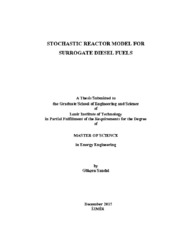Please use this identifier to cite or link to this item:
https://hdl.handle.net/11147/4549| Title: | Stochasting reactor model for surrogate diesel fuels | Other Titles: | Dizel Yerine Kullanılan Yakıtlar için Olasılıksal Reaktör Modeli | Authors: | Sandal, Gökçen | Advisors: | Diez Rodriguez, Alvaro Mobedi, Moghtada |
Keywords: | Stochastic reactor models Diesel fuels |
Publisher: | Izmir Institute of Technology | Source: | Sandal, G. (2015). Stochasting reactor model for surrogate diesel fuels. Unpublished master's thesis, İzmir Institute of Technology, İzmir, Turkey | Abstract: | The objective of this thesis is to develop of various surrogate fuels with computational engine simulation tools based on stochastic reactor models (SRMs) in direct injection engines (DI). The SRM is based on probability density function (PDF) approach which has important ability to calculate complex reactions, energy equations and mass transfer. It is also successful to control the effects of inhomogeneities and turbulence with low computational cost. Since the diesel fuel is very complex to solve in numerical tools, surrogate fuels were tested in this study. N-heptane, n-heptane / toluene and n-heptane / isooctane mixtures were used as surrogate fuels due to their physical and chemical properties were very close to diesel fuel. These fuels were tested under different injection timings and the calculated results were compared with an experimental study’s data. Comparison of ignition delay results demonstrate a good agreement between theoretical and experimental data, but soot formations were different when compared to literature and reference study. Fuel properties, structures or discrepancy between engine operating conditions and numerical model could be the cause of these differences. Bu çalışma direkt enjeksiyonlu motorlarda dizel yakıt yerine kullanılabilecek, fiziksel ve kimyasal özelikleri bakımından dizel yakıta benzer özellik gösteren çeşitli vekil yakıtlar numerik olarak incelenmiştir. Hesaplamalar Olasılık Yoğunluk Fonksiyonu yaklaşımı timeline dayanarak, olasılıksal reaktör model kullanılarak yapılmıştır. Bu modelin en önemli avantajları homojensizliği ve türbulansı zaman ve maliyet açısından daha kolayca ve kontrol edebilmesidir. Bu amaçla enerji ve kütle transferi denklemleri çözülmüştür. Vekil yakıt kullanılmasının amacı, dizel yakıtın kompleks olmasıdır. Fiziksel ve kimyasal olarak dizele benzer yakıt kullanılarak zaman ve maliyetten tasarruf edilir. Bu amaçla öncelikle dizele özellikleri çok benzeyen tek zincirli bir molekül olan n-heptan kullanılmıştır. Daha sonra n-heptane / toluen, n-heptan / izooktan karışımları denenerek, yakıt komplekleştirilmiş ve deneysel olarak test edilen dizel ile karşılaştrılmıştır. Bunun sonucunda tutuşma gecikmeleri ve kurum miktarları saptanmıştır. Genel olarak tutuşma gecikmesi deneysel sonuçlara benzer özellik göstermiştir. Kurum miktarı, daha önceki çalışmalara ya da deneysel sonuçlara göre beklenildiğinden farklı çıkmıştır. Yakıtların özelikleri, yapıları ya da deney koşullarının, numerik hesaplamalara göre farklılık gösterebilmesi, bu farklılığın oluşmasında bir etken olabilir. |
Description: | Thesis (Master)--Izmir Institute of Technology, Energy Engineering, Izmir, 2015 Includes bibliographical references (leaves: 68-70) Text in English; Abstract: Turkish and English xi, 70 leaves |
URI: | http://hdl.handle.net/11147/4549 |
| Appears in Collections: | Master Degree / Yüksek Lisans Tezleri |
Files in This Item:
| File | Description | Size | Format | |
|---|---|---|---|---|
| T001413.pdf | MasterThesis | 1.09 MB | Adobe PDF |  View/Open |
CORE Recommender
Page view(s)
106
checked on Feb 3, 2025
Download(s)
128
checked on Feb 3, 2025
Google ScholarTM
Check
Items in GCRIS Repository are protected by copyright, with all rights reserved, unless otherwise indicated.